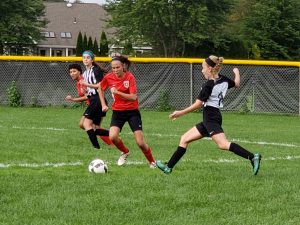Youth travel sports represent fun, opportunity … and big business
The term “youth sports” used to connote a handful of kids getting together for a pickup game in someone’s backyard or on an open field somewhere in the neighborhood. Then, Little League and other sports organizations formalized local play, introducing standardized rules, coaches, and regularly scheduled games.
Today, organized sports – especially travel sports – has become a business … big business.
Across the United States, travel sports has morphed into a $15.5 billion industry, with parents often treating an out-of-state tournament as a family vacation involving flights, hotels, restaurant meals and sightseeing, on top of the sports travel league fees.
In Connecticut, the travel sports category represents a growing economic sector, with developers – like elsewhere in the country – recognizing its enormous financial potential.
Last year, plans were announced for a $150-$200 million sports complex near Bradley International Airport in Windsor Locks. The proposed project, set for a 2020 opening, was to include an outdoor stadium, an indoor arena, two hotels and a convention center, built on some 76 acres of former tobacco land. The vision included 16 indoor basketball and volleyball courts, along with eight multipurpose synthetic turf fields for field hockey, softball, soccer, flag football and lacrosse.
The Long Island developer said he hoped “All Sports Village,” as it was dubbed, could be a premier facility for top youth athletes from around the country, and especially for Amateur Athletic Union (AAU) basketball. It was also projected to create an estimated 400 full-time and 100 part-time jobs.
According to town officials, the project is “in progress” but is still at a very early stage.
Meanwhile, in Windsor, the developer of the brand-new Fastpitch Nation Park is preparing to unveil a $3 million complex comprising 11 regulation fastpitch fields on a 20-acre parcel on Day Hill Road. The facility, the largest of its kind in New England, was the brainchild of long-time fastpitch softball coach and league official David Rocha. Opening day is April 27.
“Travel sports, whether it is softball, baseball, soccer and other sports, have mushroomed,” says Rocha, owner of Fastpitch Nation, which he created in 2008. His Bloomfield location is the largest (24,000 square feet) indoor fastpitch softball training facility in Connecticut, annually hosting more than 450 games, along with lessons and clinics.
Rocha says the new project includes a 3,200-square-foot building featuring retail space, a food court, bathrooms, and live streaming of all games on the fields. Tournaments will be played from April through October, mostly on weekends.
“There is nothing like this park anywhere in New England,” he says. “The lack of these sorts of parks, which are numerous in other areas of the country, will make our new location the most sought out park for teams to play in the region. Our goal is to create a family-oriented park with zero negative impact on the surrounding area and a huge positive economic impact for Windsor and surrounding businesses.”
Rocha, who does not field teams, says interest and excitement in Fastpitch Nation Park is already at a fever pitch.
“My facility is almost 100% per cent booked for the whole season, and we’re not even open yet.”
Baseball
Of course, youth travel sports is not just about business and profit margins. It’s also about fun … and opportunity.
Tom Nicholson, a youth baseball pitching coach with Fastpitch Nation – just one of several Connecticut organizations offering facilities and services to help children and young people achieve their athletic ambitions – perhaps put it best when asked what the allure of being part of a travel sports team is for a youngster.
“The beauty of a travel team is the open road and sky,” he says. “The Little League-aged teams I met on planes were flying over neighboring states to play. The fields and umpires available to the kids offer new limits as to where they can go to throw the horsehide around the diamond.”
But there’s more to it than just the diversity of experience. “I wouldn’t have gotten seen by as many college coaches as I did if I didn’t travel and play in national tournaments,” says Dillon Lifrieri of Wilton, now a freshman on the University of Arkansas baseball team, which advanced to the College Baseball World Series championship last year.
“Travel baseball also exposed me to players in other areas of the country and gave me an idea, especially at the start, how much I had to improve,” adds the 19-year-old Wilton High School graduate. In high school, Lifrieri was the sixth-ranked player in Connecticut by Prep Baseball Report and was ranked #293 in the nation by Perfect Game. He was the only player on his team to earn all-state honors in 2017.
“We give kids a place where they can improve,” says Dan Kennedy, director of baseball operations and player development at the Connecticut Baseball Academy in East Hartford. “If a kid wants to play college baseball or even professionally, he pretty much has to play travel baseball and get that experience and playing time.”
The baseball academy, one of the biggest training facilities in New England, fields 16 travel teams for ages 13 through 18. “Team Connecticut Baseball” squads have won numerous national titles, including last year’s 14-year-old champs.
Its travel teams compete around the country in tournaments and offer players top level competition, as well as the chance to be seen by college coaches and even Major League Baseball scouts. The academy boasts that more than 70 of its players have been selected in the Major League Baseball draft, and many others have played, or are playing, college ball.
Evan Curtiss of Simsbury is in the 13-and-under group there. “I want to get experience for high school. This is my second year and I was able to travel to New Jersey last year.” And for a starry-eyed youngster in love with baseball, New Jersey might just as well be California.
Meriden’s CT Edge Baseball Academy, a training facility with 15 travel teams for ages 8-and-under (8U) to 18-and-under (18U), competes in regional and national level tournaments. The goal is to place players in front of college and pro scouts. Says owner Dennis Boucher, “The travel program growth over the past 10 years has exploded. The exposure at a young age, along with teaching from talented and experienced coaches, places young players in a position of growth and improvement.”

Soccer
Garret Ratcliffe, director of travel soccer for Farmington Soccer, says his organization has had a “long tradition” of developing successful players at every level and “our teams continue to be among the best in Connecticut.” He added, “Winning state championships is always our long-term goal for the kids, so developing high level players who have passion and excitement is a key component.”
Most youngsters who participate in travel soccer improve significantly over those who play strictly recreational soccer. It’s simple math, really: The youngsters on travel teams get more practices per week and typically have more experienced coaches to teach them enhanced skills and tactics. Also, they are playing against stronger competition.
J.P. DiTommaso, director of events and sponsorship as well as club coach at the Farmington Sports Arena, says the draw to youth travel teams gives players and families the opportunity to travel outside their communities and experience playing soccer in new settings.
“Travel soccer becomes the true collection of players coming from different geographical areas and styles of play to create a new team. Traveling and competing locally, regionally and nationally allows players to experience the game how it is played outside of their immediate community.”
The arena is a Mecca for sports, with 130,000 square feet of indoor and outdoor fields, practice areas, a track, locker rooms, a café, and a retail store. “Our goal is to provide an environment that entices players to work hard and compete to the best of their ability,” DiTommaso says. “The travel team concept attracts established and educated coaches crucial to the development of young players. Success is achieved through the dedication of the player to grow as both an individual and a team member.”
Todd Hill, a former player with New Haven Youth Soccer who has served as a coach since 2002, says the organization’s programs have grown in recent years as families look for a balance between competitive and recreational sports. Today, the group offers a recreational league, a middle school league, and a travel league. “We have many programs that address the ever-changing landscape of youth soccer in our community. We see soccer as a means to a healthier person. The sport part is important, but we look to also build the overall health of the child.”
Tatiana O’Connor, an official with New Haven Youth Soccer, has seen growth in younger age groups, U-10 and U-12, particularly with the boys. “Parents of kids at this age level are ready to make the commitment of bringing their players to away games to play against other towns. With travel, you get to see other talented players with different levels of skill.”

Basketball
Jennifer Labrie, president of Norwich-based Connecticut Storm Girls Basketball, says players in that nonprofit club’s basketball program – especially those in older age groups – are looking to play in college.
“They are playing with the best in their area and against the best from all over the country. College scouts attend their games and recruit players that would be a good match for their college programs,” Labrie explains. “Our graduating teams from the last two years have 11 players currently playing in college and even one playing professionally. For tournaments on the weekends, older players travel all over the place.” Younger grades compete mostly locally.
Connecticut’s annual AAU boys’ and girls’ basketball tournaments currently draw more than 140 teams from around the state, with teams playing at various high schools in the spring of each year.
This year, male and female players will try to out-dribble, out-pass and out-dunk opponents at tourneys in New Haven, Woodbridge, Trumbull, Waterford, Canton, Bristol and Harwinton. But they will also travel beyond state borders to attend competitions in Rhode Island, Massachusetts, New York, New Jersey, Delaware, Pennsylvania and Virginia.
The price of participation
The word “travel,” when applied to youth sports teams, can run the gamut, from teams sponsored by individual towns and organizations to those fielded by private or semi-private facilities. The cost to play can range from hundreds to thousands of dollars a year.
The Farmington Soccer Club prides itself on being one of the lowest-cost travel programs in the state. It raises money from hosting a tournament over Labor Day weekend, which helps defray some of the cost of playing. Also, coaches and managers are volunteers, and that helps keep expenses low. “Playing soccer in Farmington is extremely affordable for any family and if they qualify, we also provide financial assistance,” says Ratcliffe.
NHYS charges $325 per player for travel teams in the fall and spring and offers financial aid. Says Hill, “The cost is fair and includes the player’s uniforms, one home and one away jersey. New Haven Youth Soccer is an absolute steal with its travel costs. The club uses a sliding scale, so the U10s will pay less than the U12 to U19s. Based on age and ability, the costs are reasonable.”
Labrie explains that playing for the Storm “is fairly expensive” due to the cost of tournaments, gym space rental fees, as well as travel to tournaments. “However, we do understand that cost may be an issue for some families, so the Storm never turns a player away due to financials. We always work with our families to make sure the athlete can play.”
Fees for intensive travel programs at the Connecticut Baseball Academy range from $500 to $2,000 per player for fall teams, while for the spring/summer season the rates are $1,950 to $3,500 per player. The spring and summer travel fees entitle players to participate in 35 to 65 games, depending upon the age bracket, and around a half dozen tournaments.
For the money, especially at the high end of the spectrum, parents and youngsters expect results.
“Our goal with The Storm is to promote the full individual,” says Labrie. “On the basketball end, we are looking at a full scope and sequence of the game, and each coach is trained on what skill set their players need before they move on to the next grade level. As coaches are passing off players, the next grade level coach knows exactly what the players have learned, and can build on those skills. The goal is that by the time they reach high school, they have a full skill set to play at a high competitive level. We also promote the individual off the court. We talk to our players about grades and making sure they are focused in school.”
Nicholson, a baseball coach who has taught and played at all levels of the game, including as a former 4-year Division I pitcher at Siena College, addresses both the mental and physical aspects of pitching with his students. Speaking both as a parent and as a professional pitching coach, he says youth travel teams – and all they encompass – should be for children and teens who are mentally, emotionally and physically ready to handle “everything that goes into traveling and playing on the road.” He adds, “Just because the parent has a good checkbook doesn’t necessarily mean it’s good for the young kid.”
Kennedy says in order to avoid burnout in one particular sport, the Connecticut Baseball Academy “encourages kids to play all sports, not just concentrate on baseball, although some do.”
DiTommaso agrees that “too much of anything can have negative effects on the mental, physical and emotional well-being of individuals. That’s why we have focused on developing programs to continue to challenge our players while avoiding the burnout phenomenon that often occurs in youth sports. We strive to find the balance between motivating and pushing players to be the best they can be, without turning them off to the sport they love.”
Today, youth travel teams are exposing boys and girls to better competition, college coaches and pro scouts, and places in the country only dreamed about when “travel” meant simply walking down to a neighborhood field or playground for a game of pickup ball.
John Torsiello is an independent writer and editor. A resident of Torrington, he writes extensively about sports, business, and general interest topics.








More Stories
Sailing the Seas: Cruising from Connecticut
To the Ends of the Earth with Nansen Polar Expeditions
River Cruising: Active Days on a Peaceful River in a Luxury Hotel That Follows You